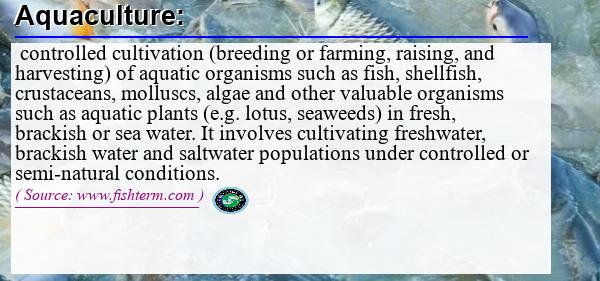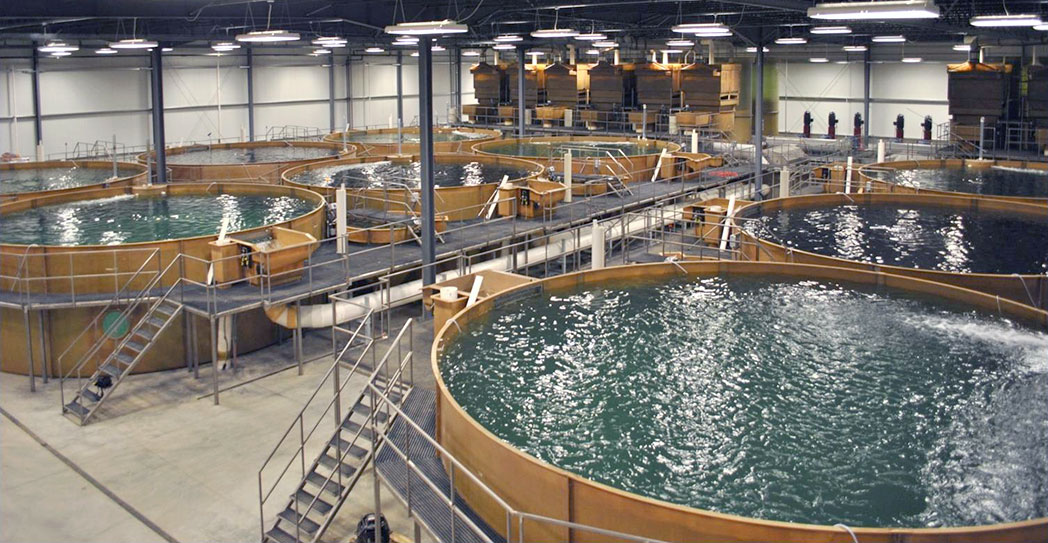Aquaculture | aquafarming | halieuculture

TABLE OF CONTENTS
Reading time:
Last modified:
2022-12-05 00:00:00
1. Synonyms, etymology, translation, definition, examples and notes
1.1. Subject field:
- Fisheries. (Hierarchy:
- Fisheries )
1.2. IPA transcription and prononciation for aquaculture, aquafarming and halieuculture:
- aquaculture: Amer. |ˈækwəkʌltʃər| Brit. |'ækwəkʌltʃə|;
- aquafarming |ˈækwə ˈfɑːmɪŋ|;
- halieucultures /ˌhalēˈ(y)ükʌltʃə/;
1.3. Synonyms of aquaculture:
There are 2 international synonyms for aquaculture. These include:

Graph 1 : aquaculture, aquafarming, halieuculture - Google ngram extract ( graph of term etymology and evolution. Source: Google ngram )
1.4. Etymology of aquaculture, aquafarming and halieuculture:
- Aquaculture: from the affix of Latin origin aqua-, ‘water’, and -culture, ‘to take care of’.
- Halieuculture: borrowed from Latin halieutica or French halieutique;
- Aquafarming: from Latin aqua- + farming;
The term aquaculture is likely to originate in the 1950s and gradually became popular till it go to its peak of popularity in the early 1990s. Another synonym, aquafarming is seldom used interchangeably with aquaculture, but not yet adopted by venerated authors in the fisheries sector. Halieuculture is another very rare frenchism synonymous to aquaculture that may be used in hyper technical documents.
1.5. French translation of aquaculture, aquafarming and halieuculture:
Aquaculture can be translated into French as:1.6. Definition of aquaculture in fisheries:

1.7. Plural of aquaculture:
Aquacultures; halieucultures; aquafarmings;
1.8. Usage example of aquaculture:
« aquaculture: rearing of aquatic animals and plants using method and techniques which enable controlled development at all life stages in an aquatic environment or any other appropriate structure. » Source: Decree No. 95/413 /PM of 20 June 1995 to lay down certain conditions for the application of the fisheries regulations., Chapter I, article 2, paragraph 8;- ; Aquafarming: Project managers are increasingly involved in carrying out aquafarming projects these days, especially in inland waters, to rear tilapia, carp, and spirulina.
1.9. Notes on aquaculture
Branches of aquaculture:
Aquaculture has several sub-sectors, some of which are subdivided into several other branches. The 6 Main subsectors of aquaculture include:- Aquaponics: extensive polyculture integrating fish, molluscs and a multiplicity of plants in the form of a symbiosis, which feed on wastes that is in turn transformed by bacteria;
- Fish farming: breeding of fish;
- Shellfish farming: farming of shellfish;
- Carcinoculture: culture of crustaceans;
- Algaculture/Algoculture: cultivation of algae;
- Integrated multi-trophic aquaculture (IMTA)
Purpose of aquaculture:
Aqua farming is done with the following objectives in mind:- to enhance production of available species through regular and controlled stocking, feeding and harvesting;
- to protect endangered species from predators by providing a culture environment which is hostile to predators and friendly to targeted species;
- to help restore depleted aquatic populations;
Origin of aquaculture
The Sumerians supplemented food supplies by maintaining fish in artificial ponds more than 4,500 years ago. According to records, ancient Egypt and Assyria also kept fish, and the Chinese were breeding carp for food by 1000 b.c. The ancient Romans kept fish for food and entertainment by circulating fresh seawater through aquariums.Aquaculture/aquafarming classification
Aquaculture, just like agriculture is a very broad sector with great diversity. As such, a simple classification is shown below according to different culture parameters of the activity:
Classification of aquaculture by water salinity:
Mariculture or marine aquaculture:
cultivation of aquatic species such as fish (cobia, salmon) or shellfish (scallops, oysters, oysters, mussels), macroalgae (seaweeds), among others in sea water.
Freshwater aquaculture:
It means aquaculture within inland waters. It is the cultivation of aquatic species such as fish or shellfish, macroalgae (seaweeds), among others in sea fresh water.
Brackish water or estuarine water aquaculture:
aquaculture in estuarine waters. It is practiced in environments where the concentration of salt varies and salinity ranges between fresh water and saline water.
Classification of aquaculture by the level of water exchange
Static aquaculture systems:
These are traditionally extensive ponds or tanks, where artificial water exchanges are used during the cultivation period.
Open aquaculture systems:
The cultivated organisms are confined or protected like in for example a tank, cages, pens, with no artificial circulation of water or within the system, the flow and quality of the water is maintained by natural water currents (stream, river, lakes or ocean).
Closed or recirculation aquaculture systems:
These aquaculture systems have minimal water exchange during the production cycle with minimal contact with the environment and the original water source. The same water is continuously purified and reinjected into the culture system
Classification of aquaculture based on Seed Origin
Domesticated Aquaculture: Seeds come from artificial reproduction conducted in hatcheries.
Capture-Based Aquaculture: this type of aquaculture relies on the use of wild seed fished from their natural environment.
Classification of aquaculture By the level of intensity of activities
Extensive or traditional aquaculture:
Simplest form of culture involving protection of the stock to improve survival rates of wild juveniles, where no fertilizer or supplementary feed is added and the production from the pond depends entirely on the primary production. The primary production in turn depends on sunlight and nutrients available in the water and soil. In the case of fish culture, it is carried out in ponds, where the fish feed on the primary production of the body of water, for this, fertilization is used. Traditional aquaculture systems have low cultivation densities, such as one fish / m2, and their productions are less than 500 kilograms per hectare.
Semi-intensive aquaculture:
A form of sea culture involving increased production by stocking at a slightly higher density and adding fertilizers (organic or inorganic) to increase primary production within the pond and in turn increase the harvest from the pond. For example, Semi-intensive fish farming is often carried out in constructed ponds which are fertilized (organic or chemical) and balanced food is provided to the animals in a complementary way. The density is between 1 and 5 fish / m2. Sometimes in these systems aeration is used that usually covers 10 to 15% of the pond area.
Intensive System:
It is carried out in ponds, cages, raceways or tanks, with permanent control of the quality of the water, feeding and production. Aeration is usually used in at least 50% of the pond area. The diet will depend only on artificial diets. The density is between 5 to 20 fish / m2, this will depend on the exchange of water and aeration supplied to the pond.
Superintensive or hyperintensive systems:
A form of mariculture involving higher stocking rates, increased depth of water (>40cm depth), increased supplementary feed with or without the use of fertilizers. Water depth in the rearing structure is greater than in the former sea farming types because the food for the cultivated organisms is not dependent entirely on primary production within the pond. Superintensive and hyperintensive aquacultures are carried out mainly in tanks, under strict control of all factors, mainly water quality, aeration and feeding. haracterised by high production cost, the culture density used is greater than 20 fish / m2; but, the peak production density reached depends on being able to keep up good water quality conditions for the organisms in culture.
Classification of aquaculture by the number of species:
Monoculture aquaculture system:
Only one species is cultivated. For example, the cultivation of only tilapia or only salmon.
Polyculture aquaculture system:
Here, two or more species are raised in the same pond or culture system. The most important consideration in polyculture is the likelihood of increasing fish production, through better use of natural foods or area of farming systems. For example, the cultivation of tilapia, shrimp and rice in the same pond. Polyculture seeks to take advantage of all the space and sets a mutualistic relationship among reared species. In this our example, the tilapia live in the water column and the shrimp in the bottom of the pond. The growing rice absorbs the waste from the tilapias and shrimps.
Integrated aquaculture:
The organic waste from the cultivation of other animals such as ducks or pigs is used, which is used for the production of microalgae, which will be food for the fish. Integrated farming has advanced further and some examples of integrated aquaculture include rice-fish farming, aquaponics, biofloc, integrated multitrophic aquaculture (IMTA) and aquamimetics. One difference between integrated aquaculture and polyculture is that the species involved in integrated aquaculture may not be raised in the same pond or rearing structure, but their rearing water may be linked through canals for nutrient transfer.
Fishery terminology records for Aquaculture
2. Images related to 'Aquaculture'

LEAVE A COMMENT



 Linkedin
Linkedin share
share tweet
tweet